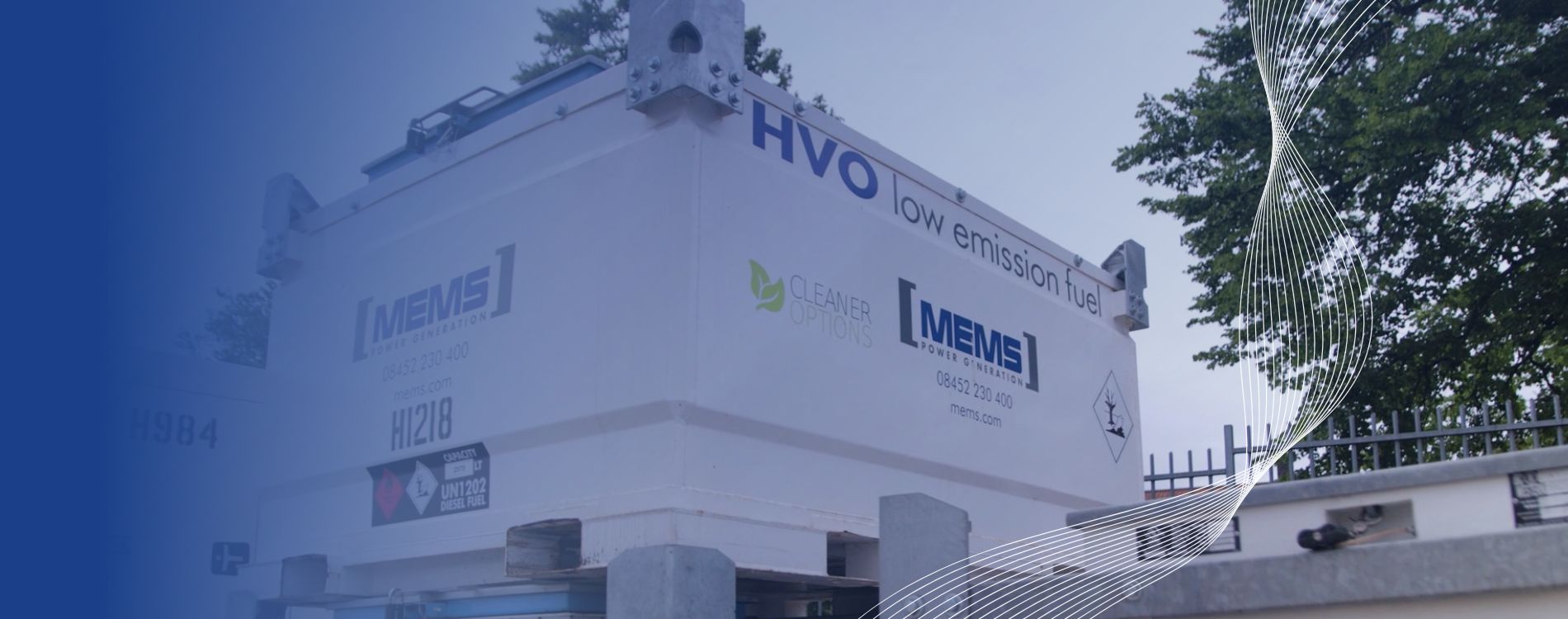Up to 90% less greenhouse emissions with hydrotreated vegetable oil (HVO), reducing your environmental impact and improving air quality. A high quality, fossil free, 100% renewable fuel, drop-in replacement for traditional diesel engines.
ARE YOU IN THE KNOW ABOUT HVO?
With MEMS, you can reduce emissions without compromising performance.
When it comes to sustainability, reducing emissions and your carbon footprint, we all have a role to play. Burning fossil fuels, like conventional diesel, is one of the main contributors to greenhouse gas emissions. However, climate change and environmental commitments mean we must all look for cleaner alternatives to generate power. That’s why MEMS is working to make a difference by offering HVO (stands for hydrotreated vegetable oil), helping you switch from regular diesel.
100% renewable raw materials collected from waste and residues such as vegetable oils, animal oils, and animal fats are used exclusively in the synthesis of HVO. As a result, hydrotreated vegetable oil will bring significant reductions in greenhouse gases and can reduce net CO₂ greenhouse gas emissions by up to 90%. Not only is it environmentally friendlier than diesel but also offers a sustainable fuel solution until future technologies are viable for the temporary power market.

HVO Advantages
- 100% renewable
- Up to 90% lower greenhouse gas emissions
- Up to 30% lower unburnt Hydrocarbon (HC)
- Up to 25% lower Carbon Monoxide (CO)
- Up to 10% lower Nitrogen Oxide (NOx) emissions
- Up to 30% lower Particulate Matter (PM) emissions
- With a low cloud point of -32°C and a high cetane number of up to 90, cold weather performance is improved, and fuel waxing is less likely to occur in freezing conditions
- Increases your business’s corporate social responsibility and operating in low-emission areas
Never Run Out of HVO With Remote Monitoring
The MEMS telemetry system Connect is our bespoke cloud solution that connects our fleet in the field to our 24-hour control room, ensuring maximum uptime and scalable performance. For example, without you needing to do anything, we automatically monitor fuel levels to ensure your tank never runs out. In addition to providing our customers with an unparalleled 24-hour monitoring service, MEMS offer round-the-clock live diagnostic information to engineers and technicians in the field. This ensures we can always deliver a best-in-class service to our customers and keep your business running.
Find out how MEMS Connect can help your business.
HVO FUEL FAQS
How is HVO made?
HVO (Hydrotreated Vegetable Oil) is a paraffinic fuel produced from waste vegetable oils and animal fats. It’s classified as a second-generation or advanced biofuel. Unlike traditional biodiesel, HVO is made using a hydrotreatment process that removes oxygen, sulphur, and other impurities.
The result is a clean, stable fuel with a long shelf life and consistent performance in all seasons. It’s colourless, odourless, and meets the EN 15940 fuel standard for paraffinic diesel.
Although it’s made from renewable materials, HVO closely matches the properties of fossil diesel and meets most of the EN590 road diesel specification, with the exception of density.
Does HVO perform well?
Yes. HVO performs consistently well, even in demanding conditions. It has a high cetane number, typically ranging from 70 to 90, compared to approximately 51 for standard diesel. A higher cetane number indicates faster, cleaner combustion, improved cold-start performance, and a reduced risk of waxing in low temperatures.
This makes HVO a reliable choice for critical temporary power applications, particularly where performance and uptime are crucial.
Is HVO the same as biodiesel?
No. HVO and biodiesel are derived from similar raw materials, but their production processes differ significantly. Biodiesel, often referred to as FAME (Fatty Acid Methyl Ester), is produced by esterifying oils with methanol. This can make the fuel more prone to water absorption, oxidation, and microbial growth (diesel bug), which affects its storage stability.
HVO is produced through hydrotreatment, resulting in a cleaner, more stable fuel with a longer shelf life and a lower risk of contamination. This makes it better suited for critical standby and temporary power use.
What is a second-generation biofuel?
Second-generation biofuels are made from the same sources as first-generation fuels, like used vegetable oils and animal fats, but they’re refined using more advanced processes. HVO is one of them.
As part of the paraffinic diesel family, HVO is cleaner and more consistent. It contains no sulphur, aromatics, or naphthenes, giving it a higher purity level. This results in lower CO₂ emissions during combustion and improved performance across a range of operating conditions.



